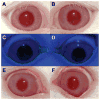Intraglandular injection of botulinum toxin a reduces tear production in rabbits
- PMID: 23128538
- PMCID: PMC3823535
- DOI: 10.1097/IOP.0b013e31826e8a86
Intraglandular injection of botulinum toxin a reduces tear production in rabbits
Abstract
Purpose: To develop an animal model and investigate the dose-dependent effect of an intraglandular injection of botulinum toxin A (BTX-A) on tear production.
Methods: In a volume of 0.1-ml, 0.625-, 1.25-, or 2.5-U BTX-A was injected transconjunctivally in the superolateral lobe of the lacrimal gland of adult New Zealand white female rabbits. In the contralateral lacrimal gland, 0.1 ml of 0.9% sodium chloride was injected. Prior to injection and at 1-week postinjection, photographs were taken to evaluate pre- and postoperative eyelid position. Fluorescein and Rose Bengal stain were used to evaluate the corneal surface, and Schirmer test was used to assess tear production.
Results: Glands injected with the intermediate (1.25 U) and the highest (2.5 U) doses of BTX-A displayed a statistically significant decrease in tear production (p = 0.002 and 0.007, respectively) compared with the contralateral saline-injected glands at 1 week. No corneal pathologic factors from excessive dryness were observed following the injection. While postinjection ptosis was observed (p = 0.025), no difference was seen between BTX-A and saline-injected eyes.
Conclusions: In rabbits, intraglandular injection of BTX-A resulted in decreased tear production at 1 week. No additional reduction in tear production was seen with a BTX-A dose greater than 1.25 U, suggesting glandular receptor saturation at this dose. Despite suppression of tear production, no corneal pathologic factors were observed. Further studies are needed to refine this animal model with the ultimate goal of determining optimum delivery route and concentration to reduction in tear production while minimizing side effects in patients.
Conflict of interest statement
The authors have no conflicts of interest to disclose.
Figures




Similar articles
-
A review on use of botulinum toxin for intractable lacrimal drainage disorders.Int Ophthalmol. 2018 Oct;38(5):2233-2238. doi: 10.1007/s10792-017-0661-9. Epub 2017 Aug 1. Int Ophthalmol. 2018. PMID: 28766277 Review.
-
Botulinum toxin B-induced mouse model of keratoconjunctivitis sicca.Invest Ophthalmol Vis Sci. 2006 Jan;47(1):133-9. doi: 10.1167/iovs.05-0380. Invest Ophthalmol Vis Sci. 2006. PMID: 16384954
-
Topical steroid and non-steroidal anti-inflammatory drugs inhibit inflammatory cytokine expression on the ocular surface in the botulinum toxin B-induced murine dry eye model.Mol Vis. 2012;18:1803-12. Epub 2012 Jul 3. Mol Vis. 2012. PMID: 22815633 Free PMC article.
-
Botulinum toxin type a injection for lateral canthal rhytids : effect on tear film stability and tear production.JAMA Ophthalmol. 2014 Mar;132(3):332-7. doi: 10.1001/jamaophthalmol.2013.6243. JAMA Ophthalmol. 2014. PMID: 24385079 Clinical Trial.
-
Botulinum toxin injection and tear production.Curr Opin Ophthalmol. 2018 Sep;29(5):428-433. doi: 10.1097/ICU.0000000000000506. Curr Opin Ophthalmol. 2018. PMID: 29994851 Review.
Cited by
-
Repeated injections of botulinum toxin-A for epiphora in lacrimal drainage disorders: qualitative and quantitative assessment.Eye (Lond). 2019 Jun;33(6):995-999. doi: 10.1038/s41433-019-0362-x. Epub 2019 Feb 14. Eye (Lond). 2019. PMID: 30765885 Free PMC article.
-
A Review of Periocular Botulinum Neurotoxin on the Tear Film Homeostasis and the Ocular Surface Change.Toxins (Basel). 2019 Jan 24;11(2):66. doi: 10.3390/toxins11020066. Toxins (Basel). 2019. PMID: 30678375 Free PMC article. Review.
-
Transconjunctival botulinum toxin injection into the lacrimal gland in crocodile tears syndrome.Indian J Ophthalmol. 2022 Apr;70(4):1339-1342. doi: 10.4103/ijo.IJO_2909_21. Indian J Ophthalmol. 2022. PMID: 35326051 Free PMC article.
-
Current practice trends for lacrimal gland neurotoxin in the management of epiphora-a BOPSS survey.Graefes Arch Clin Exp Ophthalmol. 2022 Apr;260(4):1323-1328. doi: 10.1007/s00417-021-05457-w. Epub 2021 Oct 18. Graefes Arch Clin Exp Ophthalmol. 2022. PMID: 34661734
-
A review on use of botulinum toxin for intractable lacrimal drainage disorders.Int Ophthalmol. 2018 Oct;38(5):2233-2238. doi: 10.1007/s10792-017-0661-9. Epub 2017 Aug 1. Int Ophthalmol. 2018. PMID: 28766277 Review.
References
-
- Comella JX, Molgo J, Faille L. Sprouting of mammalian motor nerve terminals induced by in vivo injection of botulinum type-D toxin and the functional recovery of paralysed neuromuscular junctions. Neurosci Lett. 1993;153:61–4. - PubMed
-
- Osako M, Keltner JL. Botulinum A toxin (Oculinum) in ophthalmology. Surv Ophthalmol. 1991;36:28–46. - PubMed
-
- Ellies M, Laskawi R, Rohrbach-Volland S, et al. Blocking secretion of exocrine glands in the head-neck area by administration of botulinum toxin A. Therapy of a rare disease picture. HNO. 2001;49:807–13. - PubMed
-
- McCoy FJ, Goodman RC. The crocodile tear syndrome. Plast Reconstr Surg. 1979;63:58–62. - PubMed
Publication types
MeSH terms
Substances
Grants and funding
LinkOut - more resources
Full Text Sources
Other Literature Sources
Medical

